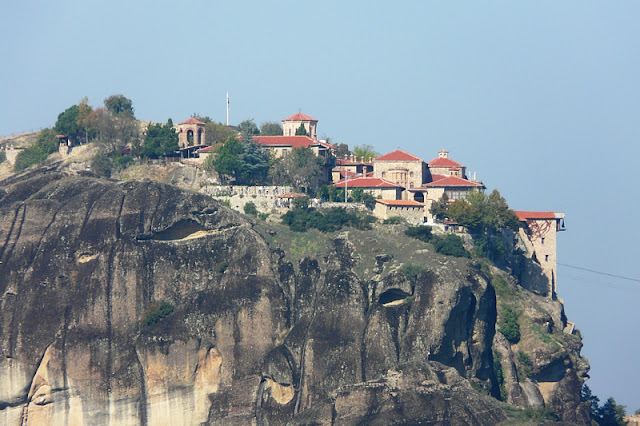Monastyr Rusanu, Świętej Barbary jest jednym z sześciu monastyrów w kompleksie Meteory w Grecji. Ten stosunkowo łatwo dostępny monastyr zajmuje niższą skalę w porównaniu z innymi monastyrami w Meteorach.
The Monastery of Rousanou/St. Barbara is one of the six monasteries of the Meteora in Greece. This easily-accessible Monastery occupies a lower rock than the others of the Meteora.
Monastyr Rusanu, The Monastery of Rousanou
Geneza jego tradycyjnej nazwy jest nieznana. Przypuszcza się, że pochodzi od imienia jakiegoś ascety Roussanosa, żyjącego niegdyś na skale, choć również nie jest wykluczone, że upamiętnia dwóch mnichów rosyjskich, którzy jakoby go wybudowali. Druga nazwa monastyru brzmi Ajia Warwara (czyli św. Barbara).
The genesis of its traditional name is unknown. It is believed that the name comes from a Roussanos who lived on a rock once or from two Russian monks who built first monastery buildings. The second name of the monastery is Agia Varvara (ie St. Barbara).
Monastyr Rusanu, The Monastery of Rousanou
Początki klasztoru są nieznane, według niepotwierdzonych historycznie danych pierwsze budynki powstały w 1288 roku. Pewne jest natomiast, że w 1529 dwaj bracia zakonni, Josafat i Maksym, pochodzący z Janiny, zastali ruiny klasztoru i zbudowali na nich nowe budynki: katolikon i cele. W XVI wieku w monastyrze działała pracownia przepisywania manuskryptów. W 1757 klasztor stał się schronieniem dla Greków uciekających przed Turkami, a w 1897, dla prześladowanych po wojnie grecko-tureckiej. Podczas II wojny światowej monastyr został obrabowany. Ponowne otwarcie klasztoru nastąpiło w 1971. W latach 80. XX wieku przeprowadzono gruntowny remont i rekonstrukcję obiektu, a w 1988 klasztor został przekazany zakonnicom.
The origins of the monastery is unknown, according to unconfirmed data, the first buildings were erected in 1288. It is certain, however, that in 1529 two brothers, Ioasaph and Maximus from Ioanina, found the ruins of a monastery and built new buildings: katholikon and goals. In the sixteenth century in the monastery some manuscripts were rewriting. In 1757, the monastery became a refuge for Greeks fleeing from the Turks, and in 1897, for the persecuted after the Greco-Turkish War. During World War II the monastery was robbed. The monastery was re-opened in 1971. In the 80s of the twentieth century were made a major reconstruction of the object, and from 1988 the monastery is inhabited by nuns
Monastyr Rusanu, The Monastery of Rousanou
Zabudowania klasztorne zajmują trzy poziomy: katolikon jest na środkowym, cele, pokoje gościnne, pokój przyjęć na wyższym, natomiast na niższym poziomie znajdują się pracownie i pomieszczenia gospodarcze. Główny kościół pod wezwaniem Przemienienia Pańskiego został wybudowany w roku 1530 i ozdobiony freskami w 1560. Do najbardziej interesujących należą: Sąd Ostateczny, sceny męczeństw w narteksie oraz Wniebowzięcie Marii Panny w nawie.
The monastic buildings occupy three levels: katolikon is in the middle, goals, guest rooms, reception room on a higher, but at a lower level there are workshops and utility rooms. The main church of the Transfiguration of Christ was built in 1530 and decorated with frescoes in 1560. To the most interesting belong: the Last Judgement, the scene of martyrdom in the narthex and the Assumption of the Virgin Mary in the nave.
Monastyr Rusanu, The Monastery of Rousanou

















